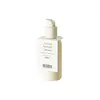What's inside
What's inside
 Key Ingredients
Key Ingredients

 Benefits
Benefits

 Concerns
Concerns

No concerns
 Ingredients Side-by-side
Ingredients Side-by-side

Water
Skin ConditioningCaprylic/Capric Triglyceride
MaskingPropanediol
SolventCetearyl Alcohol
EmollientGlycerin
HumectantPanthenol
Skin ConditioningPrunus Armeniaca Kernel Oil
MaskingOleic/Linoleic/Linolenic Polyglycerides
EmollientCetearyl Olivate
Xylitylglucoside
HumectantEctoin
Skin ConditioningSqualane
EmollientAnhydroxylitol
HumectantSorbitan Olivate
EmulsifyingPotassium Cetyl Phosphate
EmulsifyingPhenoxyethanol
PreservativeCarbomer
Emulsion StabilisingGlyceryl Stearate
EmollientJojoba Esters
EmollientBenzyl Alcohol
PerfumingMaltodextrin
AbsorbentXylitol
HumectantSodium Lauroyl Lactylate
EmulsifyingButylene Glycol
HumectantDisodium Stearoyl Glutamate
CleansingHelianthus Annuus Seed Wax
Skin ConditioningSodium Hydroxide
BufferingMadecassoside
AntioxidantLactobacillus Ferment
Skin ConditioningEthylhexylglycerin
Skin ConditioningDehydroacetic Acid
PreservativeCeramide NP
Skin ConditioningHelianthus Annuus Sprout Extract
Skin ConditioningCeramide AP
Skin ConditioningPhytosphingosine
Skin ConditioningCholesterol
EmollientPolyglycerin-3
HumectantXanthan Gum
EmulsifyingSodium Benzoate
MaskingCentella Asiatica Leaf Extract
Skin ConditioningCeramide EOP
Skin ConditioningWater, Caprylic/Capric Triglyceride, Propanediol, Cetearyl Alcohol, Glycerin, Panthenol, Prunus Armeniaca Kernel Oil, Oleic/Linoleic/Linolenic Polyglycerides, Cetearyl Olivate, Xylitylglucoside, Ectoin, Squalane, Anhydroxylitol, Sorbitan Olivate, Potassium Cetyl Phosphate, Phenoxyethanol, Carbomer, Glyceryl Stearate, Jojoba Esters, Benzyl Alcohol, Maltodextrin, Xylitol, Sodium Lauroyl Lactylate, Butylene Glycol, Disodium Stearoyl Glutamate, Helianthus Annuus Seed Wax, Sodium Hydroxide, Madecassoside, Lactobacillus Ferment, Ethylhexylglycerin, Dehydroacetic Acid, Ceramide NP, Helianthus Annuus Sprout Extract, Ceramide AP, Phytosphingosine, Cholesterol, Polyglycerin-3, Xanthan Gum, Sodium Benzoate, Centella Asiatica Leaf Extract, Ceramide EOP
Avena Sativa Seed Water
SolventGlycerin
HumectantCaprylic/Capric Triglyceride
MaskingAvena Sativa Kernel Oil
Skin ConditioningButylene Glycol
Humectant1,2-Hexanediol
Skin ConditioningGlyceryl Stearate
EmollientPolyglyceryl-2 Stearate
EmulsifyingWater
Skin ConditioningStearyl Alcohol
EmollientCarbomer
Emulsion StabilisingArginine
MaskingEthylhexylglycerin
Skin ConditioningAvena Sativa Kernel Flour
AbrasiveAvena Sativa Kernel Extract
Abrasive
 Reviews
Reviews

Ingredients Explained
These ingredients are found in both products.
Ingredients higher up in an ingredient list are typically present in a larger amount.
Butylene Glycol (or BG) is used within cosmetic products for a few different reasons:
Overall, Butylene Glycol is a safe and well-rounded ingredient that works well with other ingredients.
Though this ingredient works well with most skin types, some people with sensitive skin may experience a reaction such as allergic rashes, closed comedones, or itchiness.
Learn more about Butylene GlycolThis ingredient is an emollient, solvent, and texture enhancer. It is considered a skin-softener by helping the skin prevent moisture loss.
It helps thicken a product's formula and makes it easier to spread by dissolving clumping compounds.
Caprylic Triglyceride is made by combining glycerin with coconut oil, forming a clear liquid.
While there is an assumption Caprylic Triglyceride can clog pores due to it being derived from coconut oil, there is no research supporting this.
Learn more about Caprylic/Capric TriglycerideCarbomer is a polymer of acrylic acid. Its main role is to create a gel consistency.
A high amount of carbomer can cause pilling or balling up of products. Don't worry, most products contain 1% or less of carbomer.
Ethylhexylglycerin (we can't pronounce this either) is commonly used as a preservative and skin softener. It is derived from glyceryl.
You might see Ethylhexylglycerin often paired with other preservatives such as phenoxyethanol. Ethylhexylglycerin has been found to increase the effectiveness of these other preservatives.
Glycerin is already naturally found in your skin. It helps moisturize and protect your skin.
A study from 2016 found glycerin to be more effective as a humectant than AHAs and hyaluronic acid.
As a humectant, it helps the skin stay hydrated by pulling moisture to your skin. The low molecular weight of glycerin allows it to pull moisture into the deeper layers of your skin.
Hydrated skin improves your skin barrier; Your skin barrier helps protect against irritants and bacteria.
Glycerin has also been found to have antimicrobial and antiviral properties. Due to these properties, glycerin is often used in wound and burn treatments.
In cosmetics, glycerin is usually derived from plants such as soybean or palm. However, it can also be sourced from animals, such as tallow or animal fat.
This ingredient is organic, colorless, odorless, and non-toxic.
Glycerin is the name for this ingredient in American English. British English uses Glycerol/Glycerine.
Learn more about GlycerinGlyceryl Stearate is a mix of glycerin and stearic acid.
It is used to stabilize the mixing of water and oil ingredients. By preventing these ingredients from separating, it can help elongate shelf life. It can also help thicken the product's texture.
As an emollient, it helps soften skin and supports barrier-replenishing ingredients.
In cosmetics, Glyceryl Stearate is often made from vegetable oils or synthetically produced.
This ingredient may not be fungal-acne safe
Fun fact: The human body also creates Glyceryl Stearate naturally.
Learn more about Glyceryl StearateWater. It's the most common cosmetic ingredient of all. You'll usually see it at the top of ingredient lists, meaning that it makes up the largest part of the product.
So why is it so popular? Water most often acts as a solvent - this means that it helps dissolve other ingredients into the formulation.
You'll also recognize water as that liquid we all need to stay alive. If you see this, drink a glass of water. Stay hydrated!
Learn more about Water